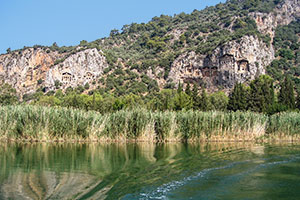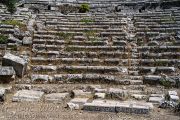Kaunos (Caunus) is an archaeological site and ancient Carian city near the holiday-resort Dalyan.
History of Kaunos
Kaunos was founded in the 9th century BC and became an important and well-known Carian city by 400 BC. According to Herodotus, the Kaunians were natives of Caria, although, they considered themselves of Cretan origin and they differed from the Carians in terms of their traditions. Kaunos was located right on the border with Lycia and its culture reflected aspects of both Caria and Lycia. The city was allied to the Lycian city of Xanthos and together they resisted the Persian invasion.
The city's wealth was mainly derived from its famous figs and salted fish, and from the production of salt and tar. Strabo reports that the city of Kaunos had dockyards and a harbour that could be closed. The great painter from antiquity Protogenes was born here and it is said that the birds took a picture of a tree made by him for real and attempted to land on it. Apart from its fish and figs, Kaunos was also known for its mosquitoes and malaria. In antiquity, people believed that those who actually died of malaria, died because they ate too many fruits. Ultimately, the sediments brought by the Dalyan stream silted the port and the marshlands became an excellent breeding ground for the mosquitoes thereby bringing death to the city.
Sights and Photos of Kaunos
Excavations began in 1967 and still take place each summer under the supervision of the Başkent University. Although not very spectacular, the ruins are certainly worth a visit with a surprisingly well-preserved theatre in Hellenistic style with a capacity of about 5,500 spectators.
https://turkeyphotoguide.com/kaunos?tmpl=component&print=1#sigProId89d5ef32f5
Travel Tips
The Kaunos Archaeological Site can be reached from Dalyan by boat across the Dalyan Çayı, the entrance to the site is a 7-minute walk from the landing point.
































